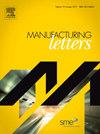调查电化学加工中 3D 打印工具的使用情况:经验教训与未来改进
IF 2
Q3 ENGINEERING, MANUFACTURING
引用次数: 0
摘要
本文介绍了如何利用三维打印技术生产用于电化学加工(ECM)的工具电极。大多数 ECM 工作都需要使用独特形状的工具,而生产这种工具需要大量费用。三维打印等增材制造工艺有可能降低生产成本,并允许设计更复杂的工具电极几何形状。这项研究中使用的工具电极是用聚乳酸(PLA)打印的,随后与铜电极配合,作为工具的电气连接终端。打算用作 ECM 电极的工具表面涂有导电涂料,然后进行电镀铜以形成导电表面。这些 3D 打印工具电极已在原型 ECM 机器中成功用于加工淬硬工具钢,但挑战依然存在。本文介绍了利用 3D 打印工具坯料开发 ECM 工具的过程、为演示工具坯料的使用而构建的原型 ECM 系统,以及应用 3D 打印坯料加工硬化工具钢的结果。此外,还讨论了下一步工作,包括对工具电极的潜在改进。本文章由计算机程序翻译,如有差异,请以英文原文为准。
Investigating the use of 3D printed tools for electrochemical machining: Lessons learned and future improvements
This paper describes the use of 3D printing in the production of tool electrodes for use in electrochemical machining (ECM). The majority of ECM jobs require the use of a unique form tool, production of which represents a significant expense. Additive manufacturing processes such as 3D printing offer the potential to lower cost of production and allow design of more complex tool electrode geometries. The tool electrodes used in this research effort were printed in polylactic acid (PLA) and subsequently fit with a copper electrode to serve as the electrical connection terminal for the tool. The tool surface intended for use as the electrode for ECM was coated with an electrically conductive paint before being copper electroplated to form a conductive surface. These 3D printed tool electrodes were successfully demonstrated to machine hardened tool steel in a prototype ECM machine, although challenges remain. This paper describes the development of ECM tools from 3D printed tool blanks, the prototype ECM system that was constructed to demonstrate use of the tool blanks, and the results of applying the 3D printed blanks to machine hardened tool steel. Next steps including potential improvements to tool electrodes are also discussed.
求助全文
通过发布文献求助,成功后即可免费获取论文全文。
去求助
来源期刊

Manufacturing Letters
Engineering-Industrial and Manufacturing Engineering
CiteScore
4.20
自引率
5.10%
发文量
192
审稿时长
60 days
 求助内容:
求助内容: 应助结果提醒方式:
应助结果提醒方式:


